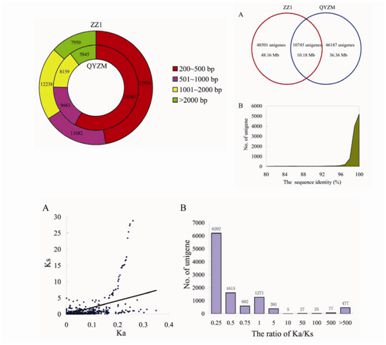分享到
Transcriptome comparison reveals the patterns of selection in domesticated and wild ramie
Researchers headed by Dr Liu Touming at the Institute of Bast Fiber Crops (IBFC) of Chinese Academy of Agricultural Sciences (CAAS) found that both artificial and natural selections accelerated the domestication of ramie from its wild relative. This research finding has been published on Plant Molecular Biology on June 17, 2014.

The domestication and cultivation of crop is one of the great inventions in human history, and has important influence on the development of human civilization. Ramie, originated from China, is a special natural fiber crop in China, and the cultivated acreage and yield in China occupied over 90%. The ramie has a centuries-old cultivated history. The archeologist found our ancestry had begun to use the ramie fiber to weave the cloth and strand before 4700 years. Recently, the scientists found the cultivated ramie had the closest relative with the wild ramie Qingyezhuma according to the molecular marker and morphological evidence, and concluded that cultivated ramie evolved from the Qingyezhuma. However, because of the shortage of ramie genomic information, the footprint of domestication is poorly understood for this old fiber crop.
Thanks for the National Natural Science Foundation project fund, the transcriptome of the cultivated ramie Zhongzhu 1 and the wild ramie Qingyezhuma were characterized by Dr Liu and his research team, and 59,246 and 56,932 unigene for the domesticated and wild ramie were generated, respectively. Sequence comparison has identified 10,745 orthologous unigene pairs between two transcriptomes. By analyzing the ratio of non-synonymous to synonymous nucleotide substitutions, they found 13 and 85 genes to undergo significant positive and purifying selection, respectively. Most of these selected genes were homologs of those involved in abiotic stress tolerance or disease resistance in other plants, suggesting that abiotic and biotic stresses were important selective pressures in ramie domestication. Two genes probably related to the fiber yield of ramie were subjected to positive selection, which may be caused by human manipulation.
The related linkage for details:
http://link.springer.com/article/10.1007/s11103-014-0214-9

The domestication and cultivation of crop is one of the great inventions in human history, and has important influence on the development of human civilization. Ramie, originated from China, is a special natural fiber crop in China, and the cultivated acreage and yield in China occupied over 90%. The ramie has a centuries-old cultivated history. The archeologist found our ancestry had begun to use the ramie fiber to weave the cloth and strand before 4700 years. Recently, the scientists found the cultivated ramie had the closest relative with the wild ramie Qingyezhuma according to the molecular marker and morphological evidence, and concluded that cultivated ramie evolved from the Qingyezhuma. However, because of the shortage of ramie genomic information, the footprint of domestication is poorly understood for this old fiber crop.
Thanks for the National Natural Science Foundation project fund, the transcriptome of the cultivated ramie Zhongzhu 1 and the wild ramie Qingyezhuma were characterized by Dr Liu and his research team, and 59,246 and 56,932 unigene for the domesticated and wild ramie were generated, respectively. Sequence comparison has identified 10,745 orthologous unigene pairs between two transcriptomes. By analyzing the ratio of non-synonymous to synonymous nucleotide substitutions, they found 13 and 85 genes to undergo significant positive and purifying selection, respectively. Most of these selected genes were homologs of those involved in abiotic stress tolerance or disease resistance in other plants, suggesting that abiotic and biotic stresses were important selective pressures in ramie domestication. Two genes probably related to the fiber yield of ramie were subjected to positive selection, which may be caused by human manipulation.
The related linkage for details:
http://link.springer.com/article/10.1007/s11103-014-0214-9
By Lyu Tuo
ibfckye@163.com
ibfckye@163.com
Latest News
-
 Apr 18, 2024Opening Ceremony of the Training Workshop on Wheat Head Scab Resistance Breeding and Pest Control in Africa Held in CAAS
Apr 18, 2024Opening Ceremony of the Training Workshop on Wheat Head Scab Resistance Breeding and Pest Control in Africa Held in CAAS -
 Apr 03, 2024IPPCAAS Co-organized the Training Workshop on Management and Application of Biopesticides in Nepal
Apr 03, 2024IPPCAAS Co-organized the Training Workshop on Management and Application of Biopesticides in Nepal -
 Mar 28, 2024Delegation from the School of Agriculture and Food Science of University College Dublin, Ireland Visit to IAS, CAAS
Mar 28, 2024Delegation from the School of Agriculture and Food Science of University College Dublin, Ireland Visit to IAS, CAAS -
 Mar 25, 2024Director of World Food Prize Foundation visited GSCAAS
Mar 25, 2024Director of World Food Prize Foundation visited GSCAAS -
 Mar 20, 2024Institute of Crop Sciences (ICS) and Syngenta Group Global Seeds Advance Collaborative Research in the Seed Industry
Mar 20, 2024Institute of Crop Sciences (ICS) and Syngenta Group Global Seeds Advance Collaborative Research in the Seed Industry
